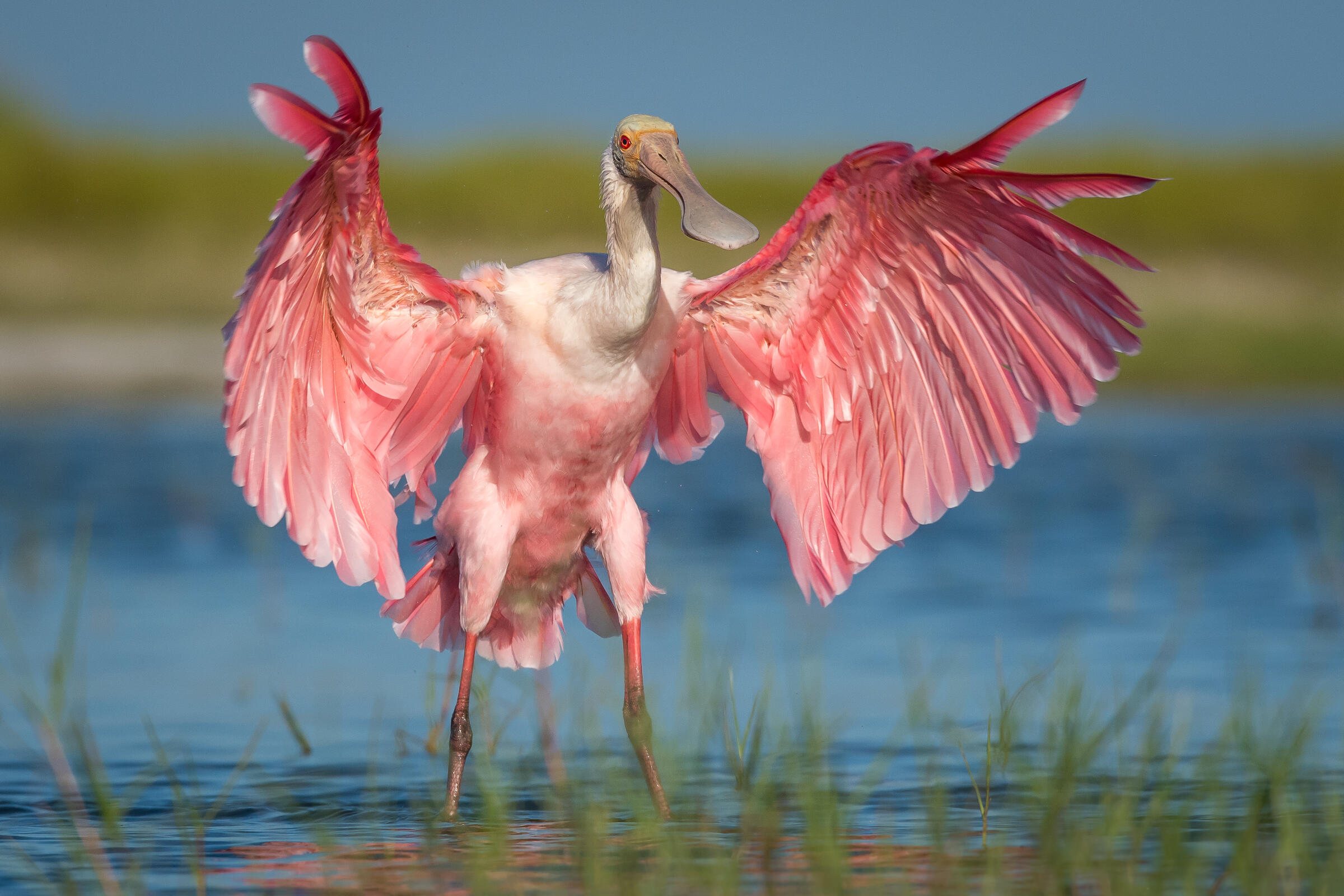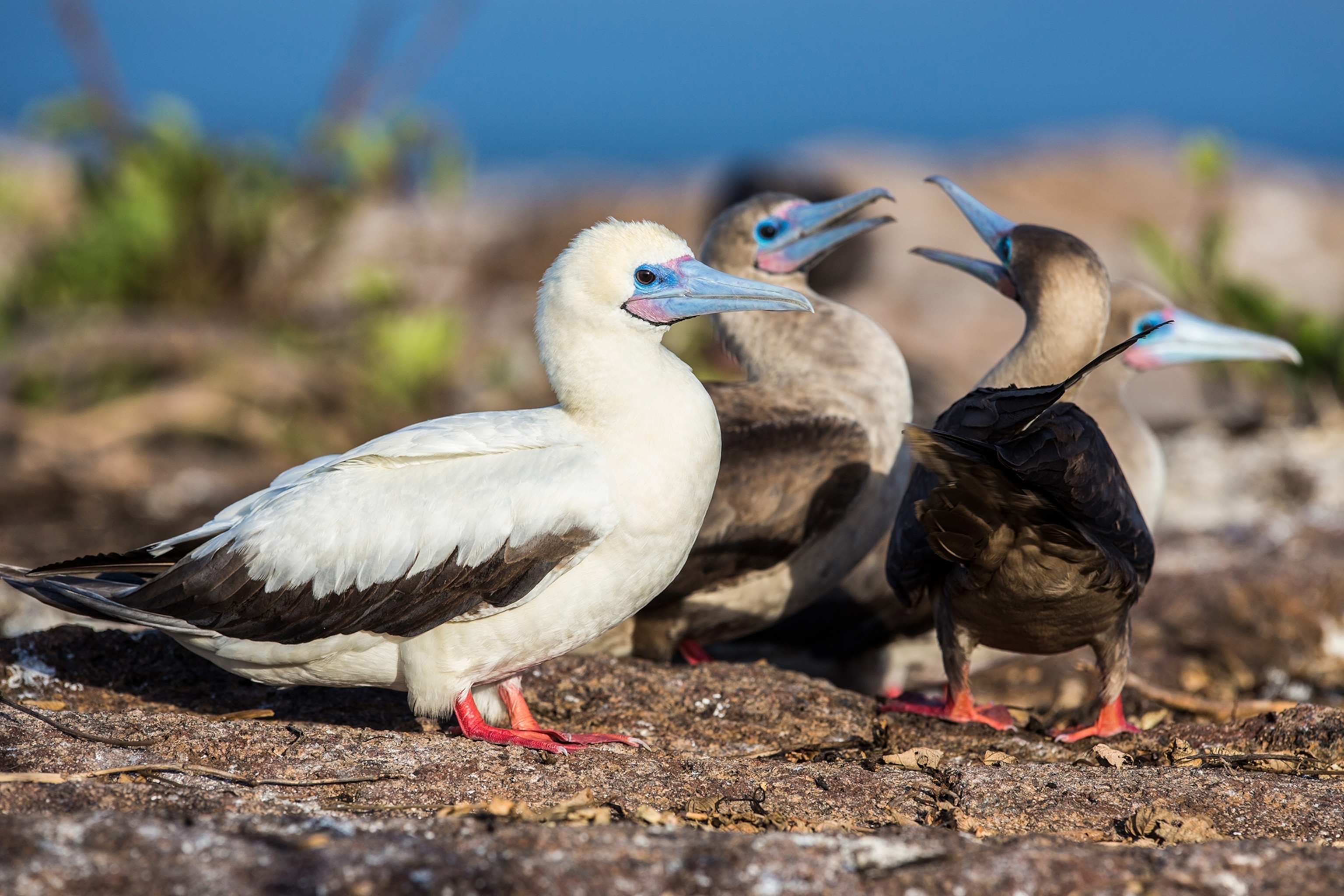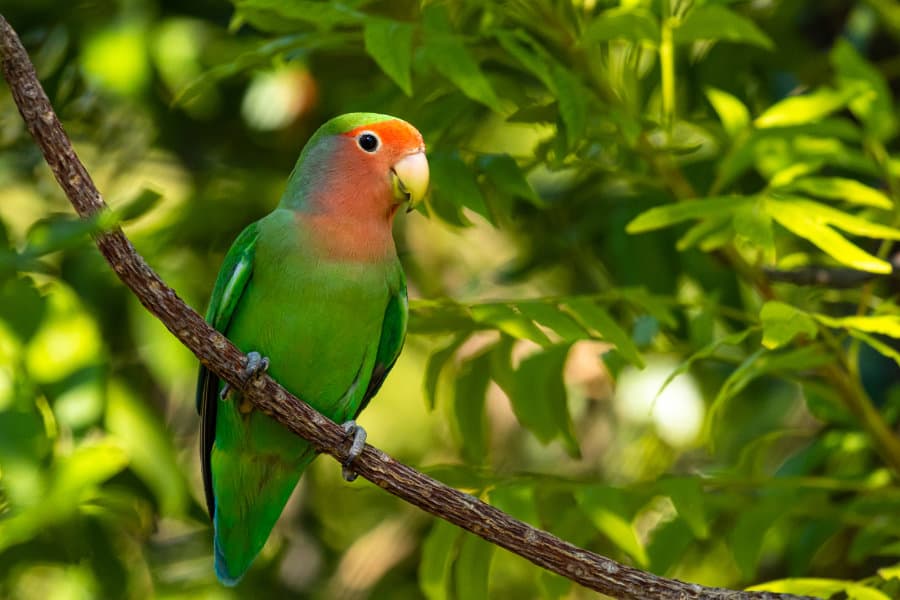I’ve always found it to be a fun conversation starter when hanging out with friends, so I figured it would be cool to bring you along for the ride. Here are the rules: each person has to name 3 birds that start with the letter “R” in 30 seconds or less. It’s simple, yet really fun if you have a group of people!
The world is full of amazing birds. Starting from the Red-tailed Hawk to the rosy-faced Lovebird, here is the list of birds that begin with R. Many of them even have beautiful names to boot.
Red-tailed Hawk (Buteo jamaicensis)
The Red-tailed Hawks are ranked as the most abundantly found members of their genus. These birds of prey have a widespread population in both North America and worldwide. Within the United States, they’re popularly called “Chickenhawk” and “Redtail.”
Because these birds have such a wide distribution, they have many subspecies, 14 of which have been recognized. These raptors occur in three main color morphs: light, dark, and intermediate.
Most of the Redtails you find within the United States are of the light morph, with the dark and intermediate morphs consisting only 10-20% of their total population within the range.
These birds have a dark brown head and upper body, whitish undersides, and a characteristic brick-red tail. They’re distinctly broad-bodied, with their head often appearing smaller in comparison.
Their legs, feet, and cere are colored in yellow, while the irises are golden-brown. Both adult sexes appear identical but display a significant dimorphism in size. The female Redtails are about 25% larger in size than their male counterparts.
Red Junglefowl (Gallus gallus)
Belonging to the Phasianidae family, the Red Junglefowls are a tropical bird species that consists of over six recognized subspecies, one of which is the domestic chicken.
These primarily ground-dwelling birds are native to Asia, abundantly found in south and southeast regions of the continent. They’re very colorful; you can find touches of grey, gold, red, brown, orange, olive, green, and white in their plumage.
The adult Red Junglefowls display a significant sexual dimorphism. The males are much larger than their female counterparts and also sport a brighter plumage. They also have golden hackle feathers around their neck that the females lack.
Red Junglefowls are primarily herbivores and enjoy feeding on fruits and seeds fallen on the ground. However, they can also hunt and feed on insects, arthropods, and small vertebrates occasionally.
Rock Dove (Columba livia)

Also referred to as “Rock Pigeons,” the Rock Doves are one of the most widely distributed members of the Columbidae family. It is from these doves that the domestic pigeons have descended.
Rock Doves have a cosmopolitan distribution and are commonly found in a variety of open and semi-open landscapes. Although their wild population is endemic to Europe, Asia, and North Africa, they’re found in almost every corner of the world as an introduced species.
Rock Doves have over twelve subspecies, and all of them display little variation in size or plumage. The nominate species have a bluish-grey head and a paler shade of the same on their body. On their neck and throat, you’ll find red, purple, green, and yellow iridescence.
Two black stripes run across their otherwise grey wings, with a darker tail. Their feet are pinkish, while the bill is grey, with a white cere at its base. Both sexes of Rock Doves appear similar; only the iridescence covering their necks is slightly less prominent in the females.
Red-breasted Merganser (Mergus serrator)
Belonging to the genus of the Sawbillls (typical diving, fish-eating ducks), the Red-breasted Mergansers are found in Europe, the Palearctic regions, and North America. Within North America, these ducks commonly inhabit freshwater lakes and rivers.
Red-breasted Mergansers are quite popular for their speed. They’ve set a record to attain an airspeed of over 100mph, which is a remarkable achievement in the world of ducks.
These diving ducks are quite bulky have a head crest and a red-colored bill. The adults are sexually dimorphic, with the males having a dark head with a green gloss, a white neck, black back, white undersides, and a rusty breast.
On the other hand, their female counterparts have an overall grey body with a rufous shade on their head. Both sexes have their separate calls as well; the males produce a weak hiccup and sneeze call, while females have a harsh and grating call that sounds like “prrak-prrak.”
Rufous Nightjar (Antrostomus rufus)
Rufous Nightjars are a nightjar species that have a widespread distribution throughout South America and the islands of the Caribbean. These birds prefer inhabiting dry, lowland, and degraded forests.
Like all the other nightjar species, Rufous Nightjars also have a dark brown plumage with paler streaking all over their bodies that helps them blend in with their surroundings. They have a nocturnal schedule and feed mainly on flying insects such as mosquitoes, locusts, moths, and beetles.
Ruby-topaz Hummingbird (Chrysolampis mosquitus)
Often simply referred to as “Ruby Topaz,” the Ruby-topaz Hummingbirds are South American hummingbird species that mainly inhabit the tropical forests.
These hummingbirds are the monotypic members of their genus and are partially migratory. However, their migration pattern is very irregular and can’t be understood easily.
The bill of Ruby-topaz Hummingbirds is what sets them apart from other hummingbird species; their bill is dark, remarkably short, and straight.
The adults are sexually dimorphic in their plumage. The males have a shining red crown, golden yellow throat, and breast, and the rest of their body is dark brown.
On the other hand, their female counterparts have a green head and upper parts and a chestnut tail, while their underparts are dull grey.
Redhead (Aythya americana)
Named after their characteristic redhead, the Redheads are a diving duck species that are also referred to as “Red-headed Pochard” and “Red-headed Duck.”
Because the Redheads forage for food underwater, their legs are placed further towards the back of their bodies. The unusual leg placement also makes walking on land difficult for these ducks. They also have a broad bill and large, webbed feet.
The adult Redheads are sexually dimorphic, with the males featuring a typical, copper-colored head and neck and a black breast. Their undersides are white, with their sides and back being grey in color.
In the non-breeding season, males lose their copper head and become brown-headed instead. On the other hand, the female Redheads have a yellowish head and neck, a brown breast, and a white belly. The rest of their body is greyish brown, with a slate-colored bill.
Ruddy Crake (Laterallus ruber)
Also referred to as “Red Rail” and “Rudy Rail,” the Ruddy Crakes are ground-dwelling birds belonging to the rail family. These birds have been named after their ruddy plumage and primarily inhabit the tall grasses, marshes, and pastures of the Americas.
Ruddy Crakes are among the smaller members of the rail family, about the same size as a sparrow. Their head is colored in dark grey, with a chestnut nape and throat and brown wings. They have red irises, a black bill, and olive-green legs and feet.
The adult Ruddy Crakes display minimal sexual dimorphism, with the females having a slightly duller plumage than their male counterparts.
Red-headed Woodpecker (Melanerpes erythrocephalus)

Although the Red-headed Woodpeckers are often confused with the Red-bellied Woodpeckers because both have redheads, the two can easily be distinguished by their appearances.
These birds are found in the temperate parts of North America; within the United States, you can locate them in the eastern and central areas.
The adult Red-headed Woodpeckers have a striking, tri-colored body, with their head and neck being covered in a vibrant shade of red. Their undersides are completely white, with their back, wings, and tail colored in black. However, their wings have a bold white bar that can easily be seen from a fair distance.
These birds have a grey bill and legs, while their irises are black. Both sexes of adults are sexually monomorphic.
Ruddy Shelduck (Tadorna ferruginea)
Also referred to as “Brahminy Ducks” in India, the Ruddy Shelduck are a shelduck species found in southeastern Europe and Asia. The eastern population of these ducks is migratory and travels to the Indian subcontinent during winters.
Ruddy Shelducks have a distinctive plumage which is a blend of orange and brown. Their head and neck are paler in comparison to the rest of their body, while the flight and tail feathers are black.
The adult males have a distinctive black collar that is absent in their female counterparts; a feature often used to distinguish their sexes.
Rivoli’s Hummingbird (Eugenes fulgens)

Named after the second duke of Rivoli, who was an amateur naturalist, the Rivoli’s Hummingbirds are a large hummingbird species found in North America. These birdies inhabit the ravines in the southwestern parts of the United States.
Rivoli’s Hummingbirds are one of the largest hummingbirds found in the United States and have a dark, only slightly curved bill. The adults display sexual dimorphism in size and plumage, with the males being a little larger than their female counterparts.
The males have a bronze-green head and upperparts, with dark underparts and a black-tipped tail. On their head, you will find a violet crown, along with a bluish-green patch on their throat.
Their female counterparts have a similar head and back, but their undersides are pale greyish. They also have white eye stripes that the males lack.
Ruff (Calidris pugnax)

Ruffs are a Eurasian wading bird species belonging to the sandpiper family. They’re migratory and gather in large flocks on their wintering grounds.
Ruffs are long-necked birds that have a significant pot belly. Both sexes of adults display a remarkable dimorphism in both size and plumage.
The male Ruffs are considerably large and have an attractive breeding plumage, particularly on their head. These birds have large feathers that act as head tufts; they can be either white or brown in color. They have an orange face, a black breast, and the rest of their body is colored in rufous-brown.
Outside of their breeding season, the males lose their head tufts and develop a greyish brown back and white undersides. The females appear similar to the non-breeding males but are smaller in size.
Red-bellied Macaw (Orthopsittaca manilatus)

The Red-bellied Macaws are a South American macaw species that belong to the mini-macaw group. These birds are medium-sized by the macaw standards and display sexual dimorphism in size.
The male Red-bellied Macaws are much larger than their female counterparts and have a larger head as well. Both sexes have a similar plumage; it is mainly green, with bluish touches to their wings and forehead.
Their face is mustard-yellow in color, with dark irises and a maroon belly patch. The legs, feet, and bill are all dark grey.
Razorbill (Alca torda)
Also referred to as “Lesser Auk” and “Razor-billed Auk,” the Razorbills are medium-sized seabirds found in the subarctic regions of the Atlantic Ocean.
The adult Razorbills are sexually monochromatic, with the males being larger than their female counterparts. They have a blackhead, back, eyes, bill, and legs, while their underbody is white.
Razorbills are capable of both diving and flight but have adapted to life in the waters. The adults are monogamous and mate for life.
Red-footed Falcon (Falco vespertinus)
The Red-footed Falcons are a migratory falcon species commonly found in the Eurasian region. These birds are among the smaller members of the falcon family.
Red-footed Falcons are significantly sexually dimorphic. The males have a bluish-grey plumage, red undertail, and legs, while their female counterparts have a white face, an orange head, and grey back and wings.
Ross’s Gull (Rhodostethia rosea)
Named after James Clark Ross, the British naturalist, Ross’s Gulls are small seabird species found in the northern parts of Siberia and Northern America.
Ross’s Gulls closely resemble the Little Gulls but are slightly larger in size. The adults have a white head and underbody, grey wings and tail, and reddish legs. Both their eyes and bill are dark in color. These gulls are sexually monomorphic.
Royal Tern (Thalasseus maximus)
The Royal Terns are a large tern species that have a widespread distribution in the Americas. These terns are only smaller in size than the Caspian Terns, making them the second-largest tern species globally.
Royal Terns have an orange bill, a black cap, and legs, grey back, and wings, while the rest of their body is all white. During winters, their black cap becomes much paler than usual. Both sexes are identical and have a short, shrilling call sound.
Red Knot (Calidris canutus)

The Red Knots are among the larger members of the Calidris sandpiper genus. These seabirds breed in Europe and Russia, along with the northern regions of Canada within North America.
Red Knots possess a small head, a short neck, and a long, tapering bill which is typical of all sandpipers within their genus. Inbreeding seasons, their face grows cinnamon in color, with the rest of their upper body being mottled grey. During winters, these birds appear paler in comparison.
Roseate Spoonbill (Platalea ajaja)

The Roseate Spoonbills are large, non-migratory spoonbill species found in North and South America. These birds lack sexual dimorphism, with both sexes having a pale greenish head, a pinkish plumage, and elongated neck, legs, and bill.
The color of their plumage is derived from their carotene-rich diet and can, thus, vary in different seasons.
Red-footed Booby (Sula Sula)

Named after their characteristic red feet, the Red-footed Boobies are one of the small members of the booby family. These seabirds are agile flies that breed in the tropic regions of the Northern Hemisphere.
Although small within their family, Red-footed Boobies are quite large in comparison to other seabirds. They occur in several morphs, all of which possess red feet in all seasons. Their light morph has a greyish white plumage, black tail feathers, and a multi-colored bill.
On the other hand, their dark morph has an overall blackish-grey plumage.
Reddish Egret (Egretta rufescens)

The Reddish Egrets are non-migratory members of the heron family found in Central and North America. They have a medium-sized body, long legs and occur in two color morphs.
The light morph has an overall white plumage, while their dark morph has a characteristic red head and neck, while their upper parts are blackish. The IUCN has declared their population to be Near-threatened.
Red-faced Cormorant (Urile urile)
Also referred to as “Violet Shag,” the Red-faced Cormorants are a large cormorant species with a widespread distribution from Japan to Alaska.
Red-faced Cormorants have a mainly bluish-green plumage, with violet touches on their sides. Their wings and tail are darker, almost black, while the face is typically red, which lends them their name.
Ringed Kingfisher (Megaceryle torquata)
The Ringed Kingfishers are a large, neotropical kingfisher species found throughout the Americas. They have three recognized subspecies, all of which vary slightly in size and coloration.
Ringed Kingfishers have a bright blue, crested head and back, a bold white collar on their nape, and rufous undersides. Their square-ended tail is also blue and contains black bands. Although both sexes appear identical, the females have a greyish chest band that the males lack.
Rosy-faced Lovebird (Agapornis roseicollis)

Also referred to as the “Rosy-collared Lovebird,” the Rosy-faced Lovebirds are an African lovebird species that commonly inhabit arid regions. These birds are noisy and gregarious, making them popular in the pet industry.
Rosy-faced Lovebirds are fairly small lovebirds with mainly green plumage and bluish rump. Their face is peachy in color, with rosy touches on their collar. They have black irises and a bone-colored bill, with both adult sexes harboring the same plumage.
Conclusion: Birds That Start With R
Birds that start with the letter R are just as diverse as those found anywhere else. They’re also just as fascinating! In this article, we’ve looked at a number of different types of birds that start with the letter R. Some, such as the robin and the raven, you’ll have no trouble spotting. But others you might have a bit more difficulty finding.
We hope you’ve enjoyed our article on birds that start with the letter R. We spent a lot of time researching this to bring you the best information.
If you’ve got any thoughts on the stuff we’ve covered here today, make sure to let us know, and don’t forget to share this article with your network on social media! Thanks again.
Birds By Alphabet (A-Z List)
Birds that Start with A
Birds that Start with B
Birds that Start with C
Birds that Start with D
Birds that Start with E
Birds that Start with F
Birds that Start with G
Birds that Start with H
Birds that Start with I
Birds that Start with J
Birds that Start with K
Birds that Start with L
Birds that Start with M
Birds that Start with N
Birds that Start with O
Birds that Start with P
Birds that Start with Q
Birds that Start with R
Birds that Start with S
Birds that Start with T
Birds that Start with U
Birds that Start with V
Birds that Start with W
Birds that Start with X
Birds that Start with Y
Birds that Start with Z












